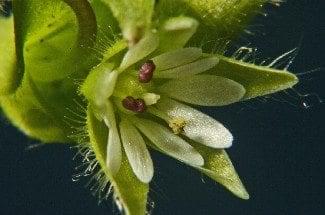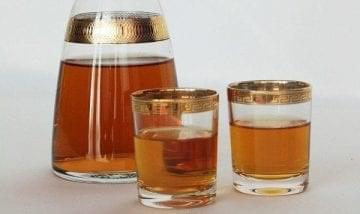Stellaria media, a. k. a. Starwort or Common Chickweed
I am always delighted to see chickweed emerging from a layer of winter mulch in my garden. This delicate plant specializes in pH balanced soils, which means the little chickweed patches are signals the heavy composting I have done all year has truly paid off. Weeding chickweed is a delight since I munch on it as I go and save the fresh aerial parts for salads and vinegars.
Medicinal Properties of Chickweed

Chickweed is a nutritious diuretic. It replenishes the body with valuable trace minerals and vitamins as it flushes water weight from stored deposits. This herb was extremely popular for this use in the Victorian era. It was tucked into landscaping and eaten by the leisure class in fancy salads and sandwiches. Chickweed escaped these gardens and fell out of favor as grocery stores with imported greens replaced the farmer’s markets. This herb does not stand much refrigeration.
Chickweed is an astringent that works wonders in drawing out splinters. Applying either the fresh juice on a cotton swab or dabbing the area with diluted tincture serves to push out slivers without the trauma of tweezers. Chickweed also helps heal the wound left behind. This makes chickweed an excellent choice for any parent or gardener’s first aid cabinet.
As a vulnerary, chickweed does its best work externally. There are few skin conditions chickweed cannot help. Minor burns, lesions, acne, wounds, eczema, insect bites, nettle burns, psoriasis, and gout all bow to chickweed’s soothing hand. This humble plant has much to offer our tender skin.
Conditions Best Helped by Chickweed

As a diuretic, chickweed is a valuable friend to patients who struggle with congestive heart failure or obesity. Water retention as witnessed by swollen ankles or bloating is eased by this herb. Other herbs chickweed is accompanied by in diuretic formulas are dandelion and parsley. All three of these herbs are also rich sources of vitamin C and potassium. Chickweed has the extra value of being high in vitamin B complex. All of these vitamins means our friend is also an excellent spring tonic.
In China, Chickweed relative Stellaria alsine is used to cool fevers and treat acne. It is also commonly given to women after giving birth to ensure rapid recovery for the mother and healthy milk flow for the baby. In some parts of Asia, women include chickweed in their diet to help regulate their menstrual cycle. With the amount of nutrition chickweed offers, it would be wise for Western women to follow this practice as well.
For more information on the conditions best helped by Chickweed, see The Practical Herbalist Conditions, including:
- skin inflammations
- acne
- eczema
- psoriasis
- constipation
- irritated eyes
List of Chickweed’s Medicinal Actions
Nutritive, diuretic, vulnerary, tonic and demulcent.
Medicinal Processing

Chickweed does well using the heat infused herbal oil technique. Using the oil in salves and ointments is simple since it combines well with other herbal infused oils like Yarrow oil or St. John’s Wort oil.
Chickweed also makes a tasty vinegar when added to apple cider vinegar and strained after a few weeks. It can blend well with other more sharply flavored infused vinegars to mellow the taste.
For more information on basic herbal preparations, see the topics in Herbal How-to.
Gardening and Gathering Chickweed
 Chickweed likes shady areas with rich, pH balanced soil. It is commonly considered a garden weed because it thrives in cultivated conditions. This herb can grow as a perennial or as an annual depending on the climate. It appears in early spring and can spread quickly if not trimmed back. Chickweed is best if harvested in the newly budded stage. Aerial parts should be collected in the morning to best preserve freshness as chickweed wilts easily.
Chickweed likes shady areas with rich, pH balanced soil. It is commonly considered a garden weed because it thrives in cultivated conditions. This herb can grow as a perennial or as an annual depending on the climate. It appears in early spring and can spread quickly if not trimmed back. Chickweed is best if harvested in the newly budded stage. Aerial parts should be collected in the morning to best preserve freshness as chickweed wilts easily.Chickweed can be collected all year round in many climates but is best harvested in the new bud stage. This is when is it freshest and tastiest; the vitamin content is high and its energy has not been completely funneled into the flowers. I prefer to collect chickweed in the mornings after a good rain. It is simply delicious then. Remember to stay away from roads, railways or areas sprayed with chemicals. These chemicals aren’t good for your body or the flavor of this tender herb.
Chickweed looks a lot like Mouse-ear Chickweed of the Ceratium genus. Mouse-ear is edible and fairly tasty after cooking but it lacks the medicinal qualities common chickweed possesses. The single line of hairs on the stem is a tell-tale sign that you have our tasty friend Common Chickweed instead of the fully hairy stemmed Mouse-ear Chickweed.
For more information on identifying this herb, the USDA Plants Profile site is an excellent resource.
Quick ID tips
Appearance: Small ground-hugging, green herb with heavily branching stems. One line of “hairs” on one side of stem which switches with the other side of the stem after each leaf node. Leaves are opposite on the stem joint and the flowers are white and delicate. Young leaves emerge close to the stem and then develop leaf stalks as they mature.
Taste: Sweet with lettuce-like flavor
Odor: Fresh, grassy scent
Using Chickweed to Care for Animals
 Poultry love chickweed, which accounts for the name. The seeds of this plant used to be popular in bird feed. Chickweed has nutritious early sprouts in the spring, which is refreshing for a winter-weary flock. Many areas have few fresh greens available when chickweed rears its cheerful head. This herb is full of trace minerals that revitalize grain fed poultry and spring’s new batch of baby birds. Chickweed has over 20 percent of its weight as a viable protein, which growing birds crave.
Poultry love chickweed, which accounts for the name. The seeds of this plant used to be popular in bird feed. Chickweed has nutritious early sprouts in the spring, which is refreshing for a winter-weary flock. Many areas have few fresh greens available when chickweed rears its cheerful head. This herb is full of trace minerals that revitalize grain fed poultry and spring’s new batch of baby birds. Chickweed has over 20 percent of its weight as a viable protein, which growing birds crave.Animals who are cage reared, like mice, hamsters, lizards or turtles, enjoy eating fresh chickweed as well. The silica content is a good choice for animals who show dull coats. The viscous fiber serves to cleanse those little bodies of toxins.
Larger animals can benefit from this herb in the same ways humans do. Nutritionally powerful and easily digestible, chickweed can be fed to horses, cows, pigs and other livestock with confidence. Chickweed poultices for cuts or chickweed tea for eye washes have helped many a homesteader through such emergencies. Do not give this herb to animals suffering from weight loss, as the diuretic actions will worsen the situation.
Household Formulas and Non-medicinal Uses of Chickweed
Its sweet, green taste makes chickweed an easy one to add to anyone’s diet via salads or as an alfalfa sprout alternative in sandwiches. This fresh taste is invigorating in spring tonic juices or smoothies. Be sure to chop it before adding it to a blender or food processor. The stems tend to wrap around whirling machine blades mercilessly.
Chopped green leaves and stems of this herb add a light zest to soups. Sprinkle finely diced chickweed on egg or tomato dishes to bring tang to the palette. This same flavor blends easily into pesto if the cook wants to focus on the nutty taste of the pine nuts or walnuts.
For more recipes and ideas for using chickweed, see The Practical Herbalist Recipes.
Cautions for Chickweed
Rarely, chickweed can cause allergic skin reactions. Allergy sensitive individuals should try a small amount first before using this herb as a medicine or food. Chickweed also contains saponins, which can cause stomach upset in very large quantities. Eat chickweed in moderation.
For more information see our History, Folklore, Myth and Magic page on Chickweed.






